@
Chapter 2. Basic proposition of Des Capital
@
(1) The eight basic propositions
@
@ I selected eight indispensable pillars in order to understand a huge
building of Capital. They are "basic propositions"to be described from now
on. Eight basic propositions picked up here are all important. If even one
of them lacks, Capital does not consist. In other words, the conclusion of
Capital does not appear.
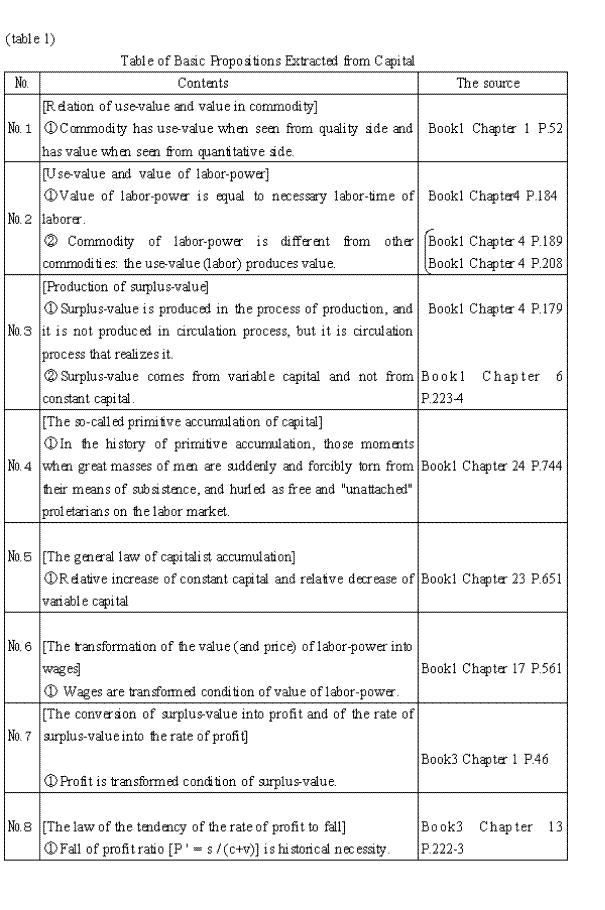
(2)
Explanation of the basic propositions
@ This is to describe summary of Capital to explain basic propositions from 1 to 8.
@
[Basic proposition 1]------Relation of use-value and value in commodity
@
@ Karl Marx begins Capital with analysis of commodity. "The wealth of those societies in which the capitalist mode of production prevails, presents itself as "an immense accumulation of commodities," its unit being a single commodity. Our investigation must therefore begin with the analysis of a commodity." (Vol. 1, p.49)
Basic proposition 1 prescribes relation of "use-value" and "value" in commodity.
@
@ Use-value (worth)
@
@ (a) Distinction of use-value
@ Use-value is a concept of "quality", and there are following distinctions. Use-value satisfies a kind of desire of human being by the physical properties of the commodity.
"A commodity, such as iron, corn, or a diamond, is therefore, so far as it is a material thing, a use-value, something useful. This property of a commodity is independent of the amount of labour required to appropriate its useful qualities."(Capital. vol 1, p.50)
And use-value is different from a thing of natural science, a thing becomes use-value when a human being discovered utility of a thing and its use.
@
@ (b) Form of use-value
@ Form of use-value is natural form. Because it is a form seen by human eyes, investigation about it is not necessary in particular.
@
@ (c) Relation with the two-fold character of the labour
@ "On the one hand, all labour is the expenditure of human labour-power in a special form and with a definite aim, and in this, its character of concrete useful labour, it produces use-values." (Capital. Vol.1, p.61)
@
A Value
@
@ (a) Distinction of value
@ Value is a concept of "quantity" and there are following distinctions. In other words value of commodity is measured by quantity of abstract human labor, and the quantity of labor is measured by its duration. And value can be changed for the reason that the quality is equal.
@
@ (b) Form of value
@ Form of value is a social form and can not be seen in human eyes. The value can only manifest itself in the social relation (the exchange-relation) of commodity to commodity. Therefore we must analyze exchange-value -- the phenomenal form-- and pursue the value-- entity-- that lies hidden behind it. (purport of Capital, vol.1, chapter 1, section 3)
@
@ (c) Relation with the two-fold character of the labor
@ On the one hand all labour is, speaking physiologically, an expenditure of human labour-power, and in its character of identical abstract human labour, it creates and forms the value of commodities.(Capital, vol.1, p.61)
@
B Relation of Use-value and Value
@
@ "A thing can be a use-value, without having value. This is the case whenever its utility to man is not due to labour. Such are air, virgin soil, natural meadows, etc.------------ But nothing can have value, without being an object of utility." (Capital vol. 1, p.55)
And we disregard use-value in exchange, and only exchange value remains. (purport of Capital, vol.1, p.52)
"As use-value, commodities are, above all, of different qualities, but as exchange-value they are merely different quantities."(Capital vol.1, p.52)
@
C@The Two-fold Character of the Labour Embodied in Commodities
@
"At first sight a commodity presented itself to us as a complex of two things: use-value and exchange-value.-------------- I was the first to point out and to examine critically this two-fold nature of the labour contained in commodities. As this point is the pivot on which a clear comprehension of Political Economy turns, we must go more into detail." (Capital vol.1, p.56)
@
@ (a) Concrete useful labor
@ "As the coat and the linen are two qualitatively different use-values, so also are the two forms of labour that produce them, tailoring and weaving. Were these two objects not qualitatively different, not produced respectively by labour of different quality, they could not stand to each other in the relation of commodities. Coats are not exchanged for coats, one use-value is not exchanged for another of the same kind." (Capital vol.1, p.56)
@
@ (b) Abstract human labor
@ "Tailoring and weaving, though qualitatively different productive activities, are each a productive expenditure of human brains, nerves, and muscles, and in this sense are human labour. They are but two different modes of expending human labour-power."(Capital vol.1, p.58`p.59)
"Just as in viewing the coat and linen as values, we abstract from their different use-values, so it is with the labour represented by those values: we disregard the difference between its useful forms, weaving and tailoring. As the use-values, coat and linen, are combinations of special productive activities with cloth and yarn, while the values, coat and linen, are, on the other hand, mere homogeneous congelations of undifferentiated labour, so the labour embodied in these latter values does not count by virtue of its productive relation to cloth and yarn, but only as being expenditure of human labour-power." (Capital vol.1, p.59)
@
D Abstraction
@
@ "Among the various kinds of properties that commodity possesses, use-value differs in quality each other. And because it is subjective, there is no possibility of a measurement in it. So it is a property that all those commodities are output of labor of a human being that stay after having removed such a use-value. But it is still heterogeneous so long as this labor is concrete useful labor such as making rice or sewing clothes. Accordingly we cannot compare those sizes with each other. So when we remove a heterogeneous thing from labor, a fixed quantity of the abstract human labor which is nondiscrimination remains there. In other words the last thing which stays after having removed a qualitative thing from the property that commodity possessed is abstract equal human labor. This labor becoming crystalline in commodity is entity of value." (An Illustrated Capital p.19, written by Shinzaburou Kosimura; translation by the author)
@
@ * Labor | concrete useful labor (qualitative) @abstract human labor (quantitative)
@ * concreteness | disregard abstraction
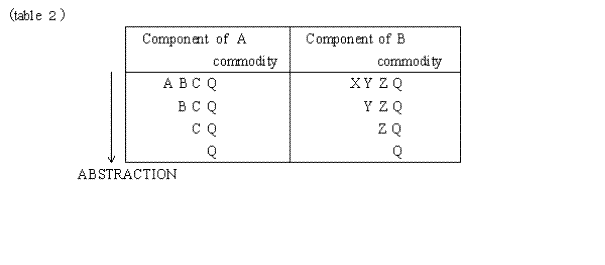
@ Explanation of basic proposition 1 has
become long. The next table summarizes this.

@ As we
have been discussing a long time about "use-value" and "value" from
outset, you may think that both of use-value and value are concerned with
this thesis all the way. But from now on we hardly discuss about
use-value, but discuss about value primarily. Both "surplus-value" and
"exchange value" are a kind of value. In other words, in Capital, after
having made clear distinction between use-value and value, it hardly
mentions about use-value. It is from the next two reasons.
@ (a) Because use value is a natural form, and there is no necessity of investigation.
@ (b) Because the motion of capital has the purpose of proliferation of value instead of use-value in the first place.
@
[Basic proposition 2]-------Use-value and value
of labor-power
@ Basic proposition 2 is that which described "use-value" and "value" when "commodity" in Basic proposition 1 is replaced by specified commodity of "labor-power".
@
[Basics proposition 2-@]
@
@ @ "Labor-power" is the commodity which is special in capitalist society. Since labor-power is not output of human labor, it is not commodity in the original sense. In other words, in commodity of labor-power, neither concrete useful labor nor abstract human labor is contained. And labor-power cannot be produced in the factory as other commodities because it is spiritual and physical ability existing in the body of laborer. But, in capitalist society, labor-power is treated as commodity, and it is bought and sold with a constant cost.
@
@ A Freedom in the double sense which is necessary for laborer to make "labor-power" a commodity (Vol.1, p.183)
@@@[T] "Personal freedom"------- As a free man he can dispose of his labour-power as his own commodity.
@@@[U] "freedom from material"------- On the other hand he has no other commodity for sale, and is short of everything necessary for the realisation of his labour-power.
@
@ B Value of "labor-power" is decided by the hours of labor which is needed to produce necessaries of life of laborer and the family.
@
[Basic proposition 2-A]
@
@ "Value of labor-power" shows itself as "wage", and "use-value of labor-power" shows itself as "labor." If a capitalist pays wage and purchases labor-power, use-value of labor-power (labor) is left to the free disposal of the capitalist. Accordingly "commodity of labor-power is different from other commodities, and the use-value (labor) produces value." (purport of Vol.1, chapter4, p.189, and chapter5, p.208)
The relation between capacity for labor and labor is equal to the relation between capacity for digestion and digestion.
@
-
@
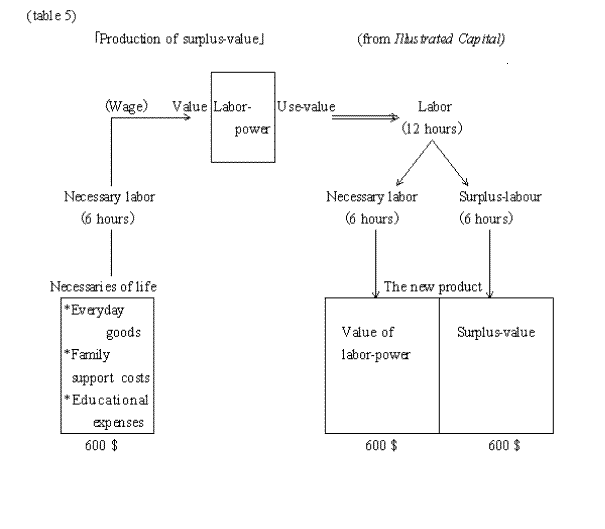
[Basic proposition 3]-------Production of surplus-value
@ Basic proposition 3 is the matter on where the surplus-value comes from. There are two points of view on "where the surplus-value comes from." One point of view is: from "which process" in reproduction process, and the other point of view is: from "which kind of capital" in various kinds of capital. The former view is basic proposition 3-@, and the latter is equivalent to basic proposition 3-A.
@
[Basic proposition 3-@]
@ Which process does surplus-value come from? We will try to consider "production process" and "process of circulation (purchase process + selling process)" here.
@
@ Purchase process
@ Movement of capital begins when money capital (M) is invested. Money capital (M) invested is paid to means of production (Pm) and value of labor-power (L). This process is purchase process. Money capital (M) becomes productive capital (P) through purchase process, and production process begins.
@
A Production process
@ In production process, use-value of labor-power (L) is combined with use-value of means of production (Pm), and productive labor is done. Productive labor is the labor which has a two-fold character, both being concrete useful labor producing use-value and being abstract human labor producing value or surplus-value. Accordingly the process of production has a two-fold character, both the labor process where concrete useful labor is done, and the process of creating value or the process of creating surplus-value where abstract human labor is done. Use-value is produced with an aspect of labor process, and surplus-value is produced with an aspect of the process of creating surplus-value. Production process of commodity by capital has signification as the process which not only produce commodity (use-value) but also produce surplus-value. Produced commodity is the commodity which contains surplus-value, and capital becomes commodity capital (C') from productive capital (P) here.
@
Summary
{Two-fold character of production process}
@ (a) Labor process-----We produce use-value with concrete useful labor. (Vol. 1, Chapter 5, Section 1)
@ (b) The process of creating surplus-value-----We produce (surplus-)value with abstract human labor. (Vol. 1, Chapter 5, Section 2)
@
B Selling process
@ Movement of capital must not remain, and produced commodity must be sold. And surplus-value must be realized. When commodity is sold, capital turns into money capital (M ') from commodity capital (C'). M' is of form of money-capital same as M which existed at the starting point, but it becomes bigger because it includes realized surplus-value. Selling process of commodity is at the same time the process where surplus-value is realized as profit . As movement of capital, both purchase process and selling process are circulation processes. Circulation process wraps production process from front and rear, and supplements it, and in total, makes the whole process of capitalist production. Above-mentioned things will be shown as in the next figure.
@
@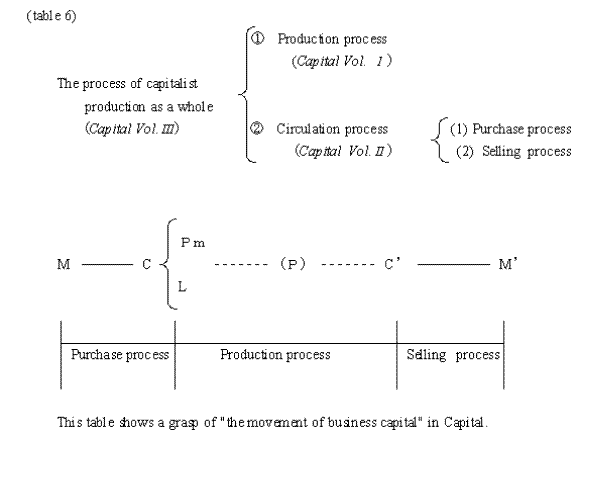
[Basic proposition 3-A]
@ Which capital does surplus-value come from? We will try to consider major aspects of capital.
@
@ Division by difference of mode of producing surplus-value
@
@ (a) Constant capital
@ Capital is divided into constant capital or variable capital whether capital produces surplus-value or not. Value of means of production thrown down as the material element of productive capital is moved on the new product according to the wear and consumption. The moved value is unchangeable through before and after the process of production. Therefore capital part cast as means of production, is called constant capital.
@
@ (b) Variable capital
@ Compared with constant capital, function of the labor-power, which is human element of productive capital, not only reproduce value of labor-power on the new product but also adds surplus-value. Therefore value cast on labor-power and value produced by function of labor-power change the size through before and after a process of production. Accordingly capital part cast on labor-power is called variable capital.
@
A Division by difference of mode of turnover of value
@
@ (a) Fixed capital
@ Capital thrown into means of labor is moved to products according to the wearing down of the value of means of labor. And, through circulation of products, it is collected partially in money form. The remaining value is always fixed in remaining parts of this capital, and becomes independent from commodity produced by function of this capital. By such a special character this constant capital part is called fixed capital.
@
@ (b) Circulating capital
@ Circulating capital and fixed capital are divided by the turnover velocity of value thrown to them. In remaining part, except a thing belonging to fixed capital from productive capital element, a part consists of constant capital element such as crude material and subsidiary material, and the other part consists of variable capital element existing as labor-power.
@ Judging from mode of turnover of value, both are generally reproduced on products via every process of production, and collected in money form through circulation of products (variable capital adding surplus-value). Based on this character, both are named circulating capital.
@
[Basic proposition 4]-------The so-called primitive accumulation of capital
@ "The so-called primitive accumulation is nothing else than the historical process of divorcing the producer from the means of production. It appears as primitive, because it forms the pre-historic stage of capital and of the mode of production corresponding with it. The economic structure of capitalist society has grown out of the economic structure of feudal society. The dissolution of the latter set free the elements of the former."(Capital Vol. 1, Chapter 24, p.742 ` 3)
@ "In the history of primitive accumulation, all revolutions are epoch-making that act as levers for the capital class in course of formation; but, above all, those moments when great masses of men are suddenly and forcibly torn from their means of subsistence, and hurled as free and "unattached" proletarians on the labor market. The expropriation of the agricultural producer, of the peasant, from the soil, is the basis of the whole process." (Capital Vol. 1, Chapter 24, p.744)
@
[Basis proposition 5]------The general law of capitalist accumulation
@ Basic proposition 5 is one of the two laws described in Capital. This law describes the effect that increase of capital gives to the fortune of the working class. That is to say: "This law of the progressive increase in constant capital, in proportion to the variable, is confirmed at every step by the comparative analysis of the prices of commodities, whether we compare different economic epochs or different nations in the same epoch. The relative magnitude of the element of price, which represents the value of the means of production only, or the constant part of capital consumed, is in direct, the relative magnitude of the other element of price that pays labour (the variable part of capital) is in inverse proportion to the advance of accumulation."(Vol.1, Chapter 23, p.651)
@ Constant capital in this case is "the value of the means of production is consumed", and "the value of the means of production not consumed" is not contained.
@
[Basic proposition 6]------The transformation of the value (and respectively the price) of labor-power into wages
@ The wage-form thus extinguishes every trace of the division of the working-day into necessary labour and surplus-labour, into paid and unpaid labour. All labour appears as paid labour. In respect to the phenomenal form, "value and price of labour," or "wages," as contrasted with the essential relation manifested therein, viz., the value and price of labour-power, the same difference holds that holds in respect to all phenomena and their hidden substratum. The former appears directly and spontaneously as current modes of thought; the latter must first be discovered by science. (purport of Capital Vol.1, Chapter17, p.562- 4)
@ Original role of form of wage exists in concealing exploitation of wage-labour by capital.
@
[Basics proposition 7]------The conversion of surplus-value into profit and of the rate of surplus-value into the rate of profit.@
@ "We thus obtain the rate of profit s/C = s/(c+v), as distinct from the rate of surplus-value s/v. The rate of surplus-value measured against the variable capital is called rate of surplus-value. The rate of surplus-value measured against the total capital is called rate of profit. These are two different measurements of the same entity, and owing to the difference of the two standards of measurement they express different proportions or relations of this entity."(Capital Vol.3, Chapter 2, p.52-3)
@
@ This will be expressed as the following equation.
@ * Rate of surplus-value s'= s (surplus-value)/ v (variable capital)
@ * Profit ratio p'= s(surplus-value)/ C (total capital) = s (surplus-value) / {c (constant capital) + v (variable capital)}
@
@ In other words, profit ratio is different from rate of surplus-value in the denominator only. The former is variable capital, and the latter is total capital. Value of surplus-value and profit is equal. It is alike for the name of one river to be different in the upper streams and the lower streams.
@ And even if surplus-value occurs with a process of production, we cannot see it till it passes the process of sale, and the measurement is impossible, either. Surplus-value appears as profit. Accordingly surplus-value and profit may be originally different, but as a result, become same in quality and amount. The surplus-value that is not realized is an empty theory and nonsense in actuality.
@
[Basic proposition 8]------The law of the tendency of the rate of profit to fall.
@ Basic proposition 8 is one of the two laws described in Capital. Formula of profit ratio led from the basic proposition 7 can transform as below.
@
@ Profit ratio P' = s / C c c c c@c c c c (A)
@@@@@@@ = s'{v / (c+v)} c c c c c c(B)
@
Formula of [s = s' v] is applied in the modification from (A) to (B).
(s = surplus-value, s '= rate of surplus-value, v= variable capital)
What we must pay attention to in this formula [s = s' v] is that basic proposition 3-A "surplus-value produces only from variable capital" exists behind this formula.
@ Next, we apply basic proposition 5 after having transformed (B) furthermore. Then, the basic proposition 8@"The law of the tendency of the rate of profit to fall" seems to be right.
@
@ Profit ratio P' = s' {v/ (c+v)} c c c c c (B)
@@@@@@@ = s'{1/ (c/v+1)} c c cc c (C)
@
That is, if we divide a denominator and a numerator of expression(B) by v, it becomes expression(C). If we apply basic proposition 5 in this expression(C), "then the gradual growth of constant capital in relation to variable capital must necessarily lead to a gradual fall of the general rate of profit, so long as the rate of surplus-value, or the intensity of exploitation of labour by capital, remain the same."@(Capital, Vol. 3, P .222)
@ Basic proposition 8 is formed on the basic propositions 3, 5 and 7, as above. Accordingly if doubt occurs on credibility of basic propositions 3, 5 and 7, formation of basic proposition 8 becomes doubtful, too.
@ In this section, basic propositions 1 to 8 were explained. And we could grasp a total image of Capital.
@
(3) Intonation of Capital
@ In this section, I will show positioning in Capital of basic propositions No.1 to No.8.@The next table is got by putting the number of basic propositions at the right of contents of Capital.
@
-
@
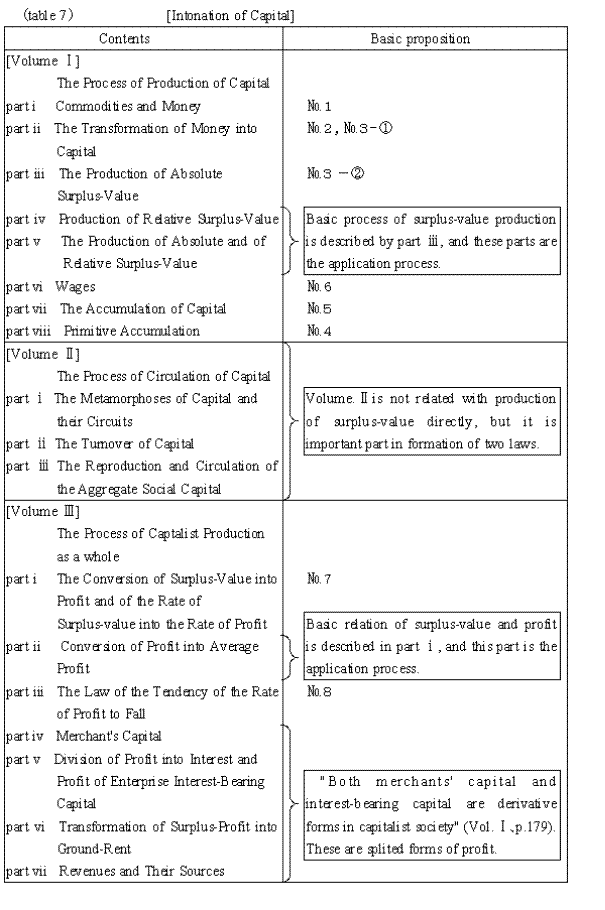
@ There are four places of contents where basic propositions are not put in this table. The four places are the parts where application process or derivative form of basic propositions is discussed. These parts in Capital are not unnecessary. But they correspond to application parts when Capital is divided into basics and applications. Then basic propositions did not come from them.
@
@ Concrete reasons will be as follows.
@ As basic process of surplus-value production is described in parts 1 to 3 of BookT, basic propositions are not extracted from part 4 and part 5 that explained the application process.
@
A BookU is the part where circulation process of capital is discussed. As Karl Marx expressed, "surplus-value is produced through the process of production, and not produced through circulation process" (basic proposition 3). Accordingly BookU is different in standpoint of statement when compared with Capital BookTand BookV which discuss production of surplus-value. From such a reason, a basic proposition is not extracted from the BookU. But, in BookU, an important matter is discussed controlling the formation of two laws, described in BookTand BookV. So, in this thesis, the part is mentioned in Chapter 3.
@
B Fundamental relation of surplus-value and profit is described in BookV part 1. Accordingly a basic proposition is not extracted from BookV part 2 that discussed the applied relation.
@
C@"......., we shall find that both merchants' capital and interest-bearing capital are derivative forms"(Vol. 1, p.179). Accordingly a basic proposition is not extracted from BookV parts 4 to 7 where they were discussed.
@ When we check Capital this way, we find both an accent and an intonation there.
@
(4) Sketching of Capital by basic propositions
@ In this section, I will try to sketch Capital by basic propositions Nos.1 to 8. The next figure shows it.
@
@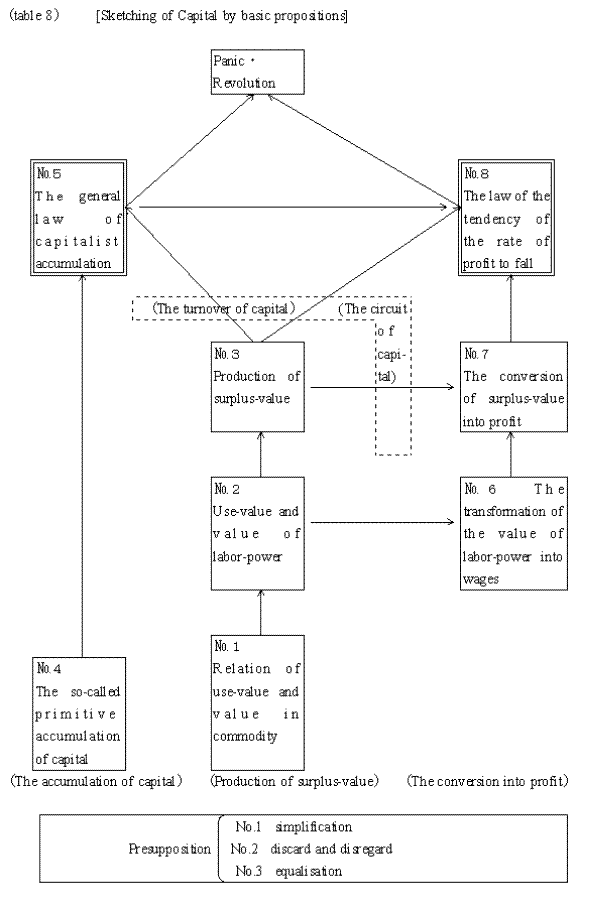
@ Central basic propositions 1, 2 and 3 show a frame of Capital in production of surplus-value. They support the pillars of right and left of Capital furthermore. Basic propositions 4. and 5 in the left show accumulation of capital. Basic propositions 6, 7 and 8 in the right show conversion to wages of value of labor-power and conversion to profit of surplus-value.
@ If basic propositions 1 to 5 are called "essence" of capital movement, basic propositions 6 to 8 can be said to be "phenomenon form" of capital movement. And conclusion of Capital "necessity of crisis and revolution" forcing us to shift from capitalist society to communist society, is led from two laws of basic propositions 5 and 8. The relation between the two laws is as follows.
@
@ First, according to "the general law of capitalist accumulation," laborer becomes misery by exploitation and at last all at once rises in revolt and will raise revolution against capitalist. "The knell of capitalist private property sounds. The expropriators are expropriated." (Capital Vol.1, Chapter 24, p.791)
@
A Next, according to "the law of the tendency of the rate of profit to fall", even if a revolution does not happen at this stage, capitalist is caught in his own trap when impoverishment of laborer goes along furthermore. After all, profit ratio falls, and management becomes difficult, and capitalist society collapses.
@
@ Though many criticisms on Capital have been made, only partial errors were pointed out and the essential defects were not pointed out till now. People are only surprised at the gap between anticipation of Capital and the actual world of today. The reasons can be shown by next two points.
(a) It was difficult for us to catch the total image of the Capital.
(b) There was not a point of view that essential defects of the Capital could be pointed out.
@
@ I think I could introduce the total image of the Capital, which was the first hurdle by "Chapter 1, Prerequisite of Capital" and "Chapter 2, Basic proposition of Capital" of this work. So, in the following chapters, I want to try to point out essential defects of the Capital, which is the second hurdle. The unique point of view will be comparisons of Capital vol. 2 and accounting theory.
@
Next page (Chapter 3)